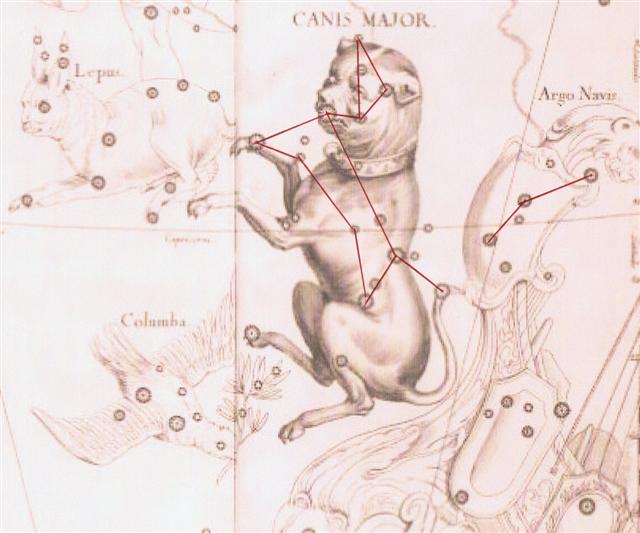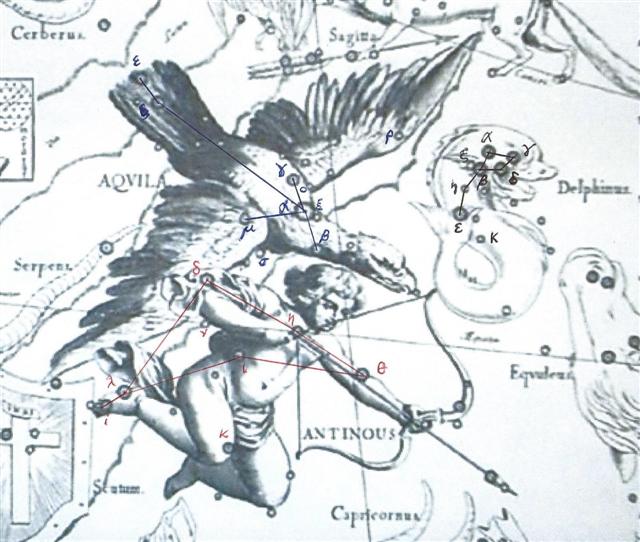The end of side a on the G tablet seems to be coordinated with the end of the year at the time of Gregory XIII. The Sun was rising with Al Baldah in ºJanuary 1 and together with Alrami 3 days later, and an inversion is illustrated in Ga8-22 corresponding to ºDecember 31. At the time of rongorongo this 'happened to be' at 19h:
ºJanuary 5 (day 370) coincided with Gb1-1 and with heliacal Deneb Okab (Tail of the Eagle). My notation for this star is δ Aquilae (Ant.), where 'Ant.' refers to the Antinous, a constellation nowadays embedded in Aquila. We can compare with Ca5-2 where Alrami was at the Full Moon and followed the next night by Deneb Okab, at the time when the Sun reached the Virgin (Aludra, at the tail of Canis Major), at the end of the first half of the year:
The Virgin (Aludra) rose with the Sun in July 7 (*108) and *108 + 183 = *291 (January 6) was at the Eagle's Tail = at the right elbow of Antinous:
The Old Eagle was descending in the day after the Archer (Alrami) and Hevelius depicted Antinous as a young new archer. ... In late September or early October 130, Hadrian and his entourage, among them Antinous, assembled at Heliopolis to set sail upstream as part of a flotilla along the River Nile. The retinue included officials, the Prefect, army and naval commanders, as well as literary and scholarly figures. Possibly also joining them was Lucius Ceionius Commodus, a young aristocrat whom Antinous might have deemed a rival to Hadrian's affections. On their journey up the Nile, they stopped at Hermopolis Magna, the primary shrine to the god Thoth. It was shortly after this, in October [in the year A.D.] 130 - around the time of the festival of Osiris - that Antinous fell into the river and died, probably from drowning. Hadrian publicly announced his death, with gossip soon spreading throughout the Empire that Antinous had been intentionally killed. The nature of Antinous's death remains a mystery to this day, and it is possible that Hadrian himself never knew; however, various hypotheses have been put forward. One possibility is that he was murdered by a conspiracy at court. However, Lambert asserted that this was unlikely because it lacked any supporting historical evidence, and because Antinous himself seemingly exerted little influence over Hadrian, thus meaning that an assassination served little purpose. Another suggestion is that Antinous had died during a voluntary castration as part of an attempt to retain his youth and thus his sexual appeal to Hadrian. However, this is improbable because Hadrian deemed both castration and circumcision to be abominations and as Antinous was aged between 18 and 20 at the time of death, any such operation would have been ineffective. A third possibility is that the death was accidental, perhaps if Antinous was intoxicated. However, in the surviving evidence Hadrian does not describe the death as being an accident; Lambert thought that this was suspicious. Another possibility is that Antinous represented a voluntary human sacrifice. Our earliest surviving evidence for this comes from the writings of Dio Cassius, 80 years after the event, although it would later be repeated in many subsequent sources. In the second century Roman Empire, a belief that the death of one could rejuvenate the health of another was widespread, and Hadrian had been ill for many years; in this scenario, Antinous could have sacrificed himself in the belief that Hadrian would have recovered. Alternately, in Egyptian tradition it was held that sacrifices of boys to the Nile, particularly at the time of the October Osiris festival, would ensure that the River would flood to its full capacity and thus fertilize the valley; this was made all the more urgent as the Nile's floods had been insufficient for full agricultural production in both 129 and 130. In this situation, Hadrian might not have revealed the cause of Antinous's death because he did not wish to appear either physically or politically weak. Conversely, opposing this possibility is the fact that Hadrian disliked human sacrifice and had strengthened laws against it in the Empire ...
Allen: "Antinoüs lies in the Milky Way, directly south from the star Altair; the head of the figure at η and σ, the rest of the outline being marked by θ, ι, κ, λ, ν, and δ, all now in Aquila. Flamsteed omitted σ and ν from his catalogue, but added i [Bered at his right foot]. The constellation is said to have been introduced into the sky, in the year 132, by the Emperor Hadrian, in honor of his young Bithynian favorite, whose soul his courtiers had shown him shining in its lucida after the youth's self-sacrifice by drowning in the Nile from his belief that his master's life might thus be prolonged. This was because the oracle at Beza had asserted that only by the death of the object which the emperor most loved could great danger to the latter be averted."
Counting from the beginning of side a, at ºMay 20 (*60) there were 236 (= 4 * 59) days up to and including ºJanuary 10 (*295), when Pollux - the immortal one of the Gemini twins - was at the Full Moon.
|
||||||||||||||||||||||||||||||||||||||||||||||||||||||||||||||||||||||||||||||||||||||||||||||||||||||||||||||||||||||||||||||||||||||||||||||||||||||||||||||||||||||||||||||||
















